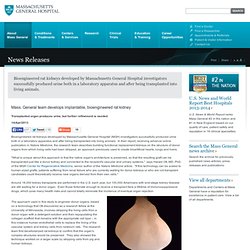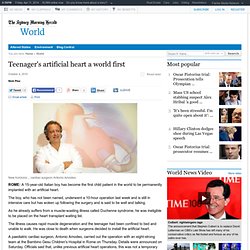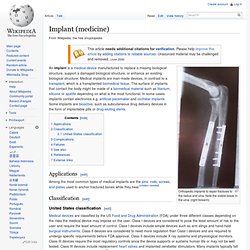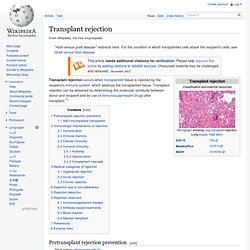

Mass. General team develops implantable, bioengineered rat kidney. Mass.

General team develops implantable, bioengineered rat kidney Transplanted organ produces urine, but further refinement is needed 14/Apr/2013 Bioengineered rat kidneys developed by Massachusetts General Hospital (MGH) investigators successfully produced urine both in a laboratory apparatus and after being transplanted into living animals. In their report, receiving advance online publication in Nature Medicine, the research team describes building functional replacement kidneys on the structure of donor organs from which living cells had been stripped, an approach previously used to create bioartificial hearts, lungs and livers.
"What is unique about this approach is that the native organ's architecture is preserved, so that the resulting graft can be transplanted just like a donor kidney and connected to the recipient's vascular and urinary systems," says Harald Ott, MD, PhD, of the MGH Center for Regenerative Medicine, senior author of the Nature Medicine article.
2011. Italian teenager's artificial heart a world first. New horizons ... cardiac surgeon Antonio Amodeo.

ROME: A 15-year-old Italian boy has become the first child patient in the world to be permanently implanted with an artificial heart. The boy, who has not been named, underwent a 10-hour operation last week and is still in intensive care but has woken up following the surgery and is said to be well and talking. As he already suffers from a muscle-wasting illness called Duchenne syndrome, he was ineligible to be placed on the heart transplant waiting list. The illness causes rapid muscle degeneration and the teenager had been confined to bed and unable to walk.
He was close to death when surgeons decided to install the artificial heart. Advertisement A paediatric cardiac surgeon, Antonio Amodeo, carried out the operation with an eight-strong team at the Bambino Gesu Children's Hospital in Rome on Thursday. Dr Amodeo said the artificial heart was about four centimetres long and had been placed inside the left ventricle.
Telegraph, London. Implant (medicine) Orthopedic implants to repair fractures to the radius and ulna.

Note the visible break in the ulna. (right forearm) An implant is a medical device manufactured to replace a missing biological structure, support a damaged biological structure, or enhance an existing biological structure. Medical implants are man-made devices, in contrast to a transplant, which is a transplanted biomedical tissue. The surface of implants that contact the body might be made of a biomedical material such as titanium, silicone or apatite depending on what is the most functional. Among the most common types of medical implants are the pins, rods, screws, and plates used to anchor fractured bones while they heal. Medical devices are classified by the US Food and Drug Administration (FDA) under three different classes depending on the risks the medical device may impose on the user. Under ideal conditions, implants should initiate the desired host response. Basu, B., Katti, D., & Kumar, A. (2009). Organ transplantation. Transplant rejection.
Transplant rejection occurs when transplanted tissue is rejected by the recipient's immune system, which destroys the transplanted tissue.

Transplant rejection can be lessened by determining the molecular similitude between donor and recipient and by use of immunosuppressant drugs after transplant.[1] Pretransplant rejection prevention[edit] The first successful organ transplant, performed in 1954 by Joseph Murray, involved identical twins, and so no rejection was observed. Otherwise, the number of mismatched gene variants, namely alleles, encoding cell surface molecules called major histocompatibility complex (MHC), classes I and II, correlate with the rapidity and severity of transplant rejection.
In humans MHC is also called human leukocyte antigen (HLA). ABO-incompatible transplants[edit] Immunologic mechanisms of rejection[edit] Immunization[edit]